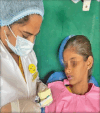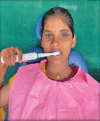Comparative Evaluation of Plaque Removal Potential of Manual Electrical and Chewable Toothbrushes in Children: A Clinical Trial
- PMID: 39867114
- PMCID: PMC11760404
- DOI: 10.5005/jp-journals-10005-3006
Comparative Evaluation of Plaque Removal Potential of Manual Electrical and Chewable Toothbrushes in Children: A Clinical Trial
Abstract
Aim and background: To evaluate and compare the efficiency of a manual, electrical, and chewable toothbrush for plaque removal in children.
Materials and methods: A total of 58 children aged 8-14 years who reported to the Department of Pedodontics. The children and guardians were familiarized with the disclosing agent, manual toothbrush, electrical toothbrush, and chewable toothbrush before the commencement of the study with the help of video and verbal demonstrations. Thirty children who were interested in participating in the study were included.
Results: The study consisted of 30 participants who were divided into three groups of 10 each-group A: manual toothbrush, group B: electrical toothbrush, and group C: chewable toothbrush. A disclosing agent was applied, and Oral Hygiene Index-Simplified (OHI-S) and Toothbrush Quality and Hygiene Index (TQHI) scores were recorded at baseline and after 1 week. The data was tabulated and subjected to statistical analysis. The data was analyzed using Statistical Package for the Social Sciences (SPSS) version 23.0. Intragroup comparisons, that is, between baseline and 1 week, were performed using the paired samples t-test. Intergroup comparisons between the three groups were performed using one-way analysis of variance (ANOVA), followed by post hoc Tukey test (pairwise comparisons). A p < 0.05 was considered statistically significant.
Conclusion: The plaque removal efficiency of electric toothbrushes is the highest, followed by the chewable toothbrush group, while the manual toothbrush group is the least. The chewable toothbrush highly surpasses the manual toothbrush group as it contains xylitol substances, which reduce Mutans Streptococcus in the plaque.
How to cite this article: Mareddy AR, Reddy VN, Done V, et al. Comparative Evaluation of Plaque Removal Potential of Manual Electrical and Chewable Toothbrushes in Children: A Clinical Trial. Int J Clin Pediatr Dent 2024;17(12):1388-1393.
Keywords: Manual toothbrush; Oral health status; Plaque index; Plaque removal; Powered toothbrush; Sensory impaired children; Streptococcus mutans.
Copyright © 2024; The Author(s).
Conflict of interest statement
Source of support: Nil Conflict of interest: NoneConflict of interest: None
Figures
References
-
- Park K. 19th ed. Jabalpur: M/S Banarsidas Bhanot Publishers; 2007. Textbook of Preventive and Social Medicine; pp. 798–806.
-
- Marsh PD. Dental plaque as a microbial biofilm. Caries Res. 2004;38(3):204–211. - PubMed
-
- Kolawole KA, Oziegbe EO, Bamise CT. Oral hygiene measures and the periodontal status of school children. Int J Dent Hyg. 2011;9(2):143–148. - PubMed
-
- Joshi AV, Dixit UB. Effectiveness of plaque removal with an experimental chewable brush in children between age 9 and 13 years. Eur Arch Paediatr Dent. 2018;19(6):417–421. - PubMed
-
- Ilyas M, Ashraf S, Jamil H. Tooth brushing techniques: relative efficacy and comparison in the reduction of plaque score in 8-11 years old children. Int Prof J Med. 2018;25(1):135–139.
LinkOut - more resources
Full Text Sources
Research Materials




